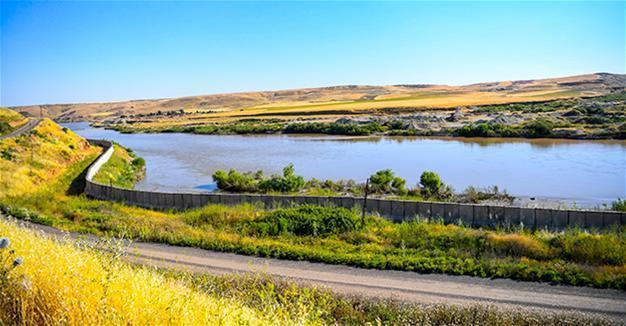Giant wall on Syrian border changes life for Turkish villagers
Gülden Aydın – MARDİN
 A wall that has been built on Turkey’s border with Syria has changed the lives of many villagers in the area, with many of them describing drastic differences in their daily lives after the construction of the wall.
A wall that has been built on Turkey’s border with Syria has changed the lives of many villagers in the area, with many of them describing drastic differences in their daily lives after the construction of the wall. The authorities say the construction of a 700-kilometer wall on the Syrian border aims to block terrorist infiltration and prevent illegal entry and exit from Turkey.
The building of the wall on the 911-kilometer border, which began in September 2016, is about to be completed, after which it will be the third longest in the world.
Two thirds of the wall pass through the southeastern provinces of Şanlıurfa, Mardin and Şırnak.
In the border areas of Mardin’s Kızıltepe district, wheat harvests can be seen bisected by the wall, which rises to three meters high with razor wires on top and which passes between Kızıltepe’s Şenyurt neighborhood and the Syrian town of Ad Darbasiyah.
The wall has transformed Şenyurt into a ghost neighborhood with a closed border gate, abandoned train stations and depleted population.
Elderly residents of the area complained about the closure of the border gate.
“The gate was open until 50 days ago. Syrian citizens with IDs were able to pass through the gate. The decision to close the gate ended trade. The youths left for elsewhere in order to find work,” one told daily Hürriyet.
Soldiers patrol the area between the former border fences and the new wall that lies in front of the border villages of Salkım and Karatepe. Howitzers were placed on piled up soil every 500 meters as a precaution against possible attacks.
Tanks and military equipment are gathered in the new military posts along the border.
The Sakalar and Arpatepe villages of Mardin’s Artuklu district can see the wall and herds graze on both sides. There are two lines of the security wall in front of Mardin’s Nusaybin district that lies across Syria’s Qamishli district.
One high school student living near the Nusaybin-Qamishli border complained about not being able to see her relatives.
“The wall was definitely a good development, but our relatives remain on the other side,” she said.
The River Tigris, which constitutes a natural border between Turkey and Syria, flows between Şırnak’s Cizre and Silopi. However, the village of Karuh’s access to the river is cut off by the wall, drawing criticism from many villagers.
“We would obtain water from the Tigris and water our fields before the erection of the wall. Now that is forbidden. It’s permitted to those with large fields, but we are obliged to obtain water from an electric well,” said one man. His niece, however, voiced her satisfaction with the security provided by the wall.
“Thank God we are at peace. We have been safer since the wall was erected,” she said.
The border gate that provided a passage for thousands of Syrians escaping from the Islamic State of Iraq and the Levant (ISIL) two years ago in Şanlıurfa’s Akçakale across Syria’s Tel Abyad was also closed.
A massive door weighing 70 tons was placed on the wall between Tel Abyad and Akçakale and the border is the scene of many Turkish flags hung as a reply against the flags of the United States and the Peoples’ Protection Units (YPG) on the Syrian side.
“The construction of the wall [in my area] ended a month ago and my view was blocked,” said İbrahim Polat, a resident of the Aşağı Kendirci village across from Syria’s Kobane.
“My sister’s field in Kobane was left on the other side of the wall. I can’t see her anymore. I won’t be able to see her if she dies,” Polat said.
















